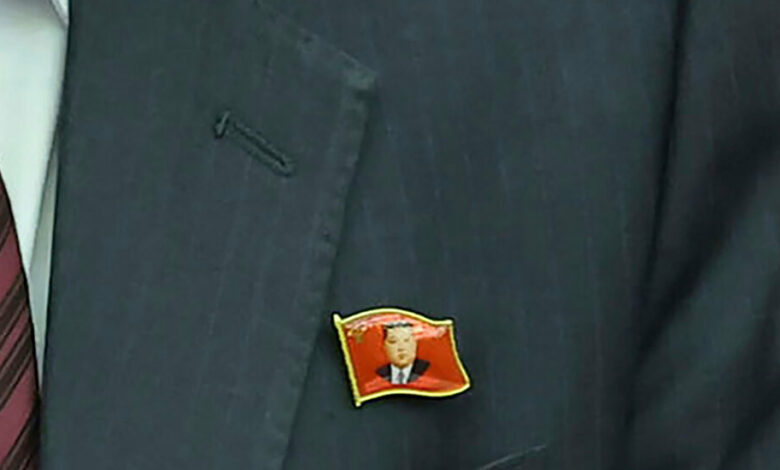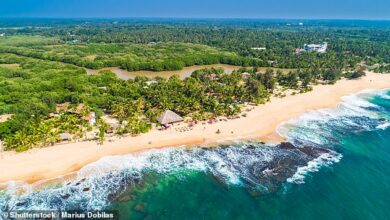North Korea’s new must-have accessory: the Kim Jong-un pin

When North Korea’s leader Kim Jong Un met with his ruling Workers’ Party last week, he had good news. The country, which has long struggled with hunger, was expecting a “fairly good” harvest this year, he said, and had recently signed a mutual defense treaty with Russia.
Perhaps the biggest news is what officials wore to the meeting in the capital, Pyongyang: breast pins with the image of Mr. Kim, according to photos released by state media.
Mr. Kim’s family has ruled North Korea since its founding in 1948 and has long indoctrinated its people to worship the Kims as divine figures. Every home and office building has portraits of Mr. Kim’s grandfather, Kim Il-sung, and his father, Kim Jong-il, hanging on the walls. Every North Korean is required to a pin with the image of one of the two senior Kims or a badge with a double image on their chest.
By introducing a pin with his own image, Mr. Kim is taking his idolization and the personality cult surrounding him to a level previously reserved for his grandfather, who ruled from 1948 until his death in 1994, and his father, who succeeded him and ruled until 2011, according to South Korean officials and analysts. The introduction means North Koreans now have three pins and images to choose from to wear.
If the tradition continues, the image of the last leader, now Kim Jong-un, will eventually become the most common choice.
“This is part of Kim Jong-un’s efforts to establish his own independent image as a leader,” Kim Inae, a deputy spokeswoman for the South Korean government’s Unification Ministry, said Monday.
North Korea introduced the Kim Il-sung badges in 1970 after the country’s founder purged all of his domestic rivals to establish a monolithic rule. Kim Il-sung was 58 at the time. Kim Jong-il’s pin was introduced in 1992, when he was 50. By then, he had established his status as heir apparent and was leading the country alongside his ailing father.
The lapel badges have since become the most recognizable feature of the personality cult. But they began to lose their appeal among ordinary North Koreans, especially after a famine in the 1990s that killed millions. Once treated as sacred objects by North Koreans, they were smuggled into China and sold as cheap tourist souvenirs near the North Korean border. Defectors from North Korea called them “slave badges.”
Ms Kim of the Unification Ministry linked the introduction of the new Kim Jong-un pin to Kim’s efforts to unite the country around his leadership as the country grapples with economic problems and the threat of outside influences, including K-pop entertainment from rival South Korea.
After taking power in 2011 following the death of his father, Kim quickly established a totalitarian leadership through what South Korean officials and analysts called a “reign of terror,” disappearing, executing or killing anyone seen as challenging his authority.
But he has struggled to fulfill his family’s promise to the long-suffering people of North Korea: to build a “strong and prosperous country” where people no longer have to tighten their belts because of food shortages or fear an invasion from the United States.
Mr. Kim has struggled economically and has been unable to convince Washington to lift sanctions imposed on his country over its development of nuclear weapons. His credentials among his people have largely rested on his carefully choreographed image as a leader who has finally made North Korea a nuclear-armed state.
Under Mr. Kim, North Korea has conducted four underground nuclear tests and developed a fleet of missiles, including long-range missiles capable of reaching the continental United States. On Monday, the final day of the Workers’ Party meeting, the country said it had tested a new ballistic missile capable of carrying a “super-large warhead.”
Despite these military successes, Kim’s hold on power depends on reviving the cult of personality and keeping North Koreans away from outside news.
Mr. Kim has attempted to reinvent his family’s rule, portraying himself as a young, energetic, and even transformative leader. He has emphasized his family lineage by dressing like his grandfather, but also seems to be distancing himself from his ancestors in an attempt to step out of their long shadow and show himself to be a worthy leader in his own right.
This year, he abandoned a long-held goal set by his grandfather, namely reunification with the South, and called Seoul an enemy that must be subdued, if necessary, through nuclear war. North Korea did not celebrate Kim Il-sung’s birthday on April 15 as much as it once did. State propagandists have begun to praise Mr. Kim in the way they once praised his father and grandfather, calling him “the sun” of the Korean people and the “father” of all Koreans, and have begun distributing portraits of him to hang in government buildings and homes.
Analysts said the distribution of the lapel pin reflected Kim’s growing confidence in his one-man dictatorship.
“It makes it official that he is now on the same level as his predecessors, Kim Il-sung and Kim Jong-il,” said Yang Moo-jin, president of the University of North Korean Studies in Seoul.




